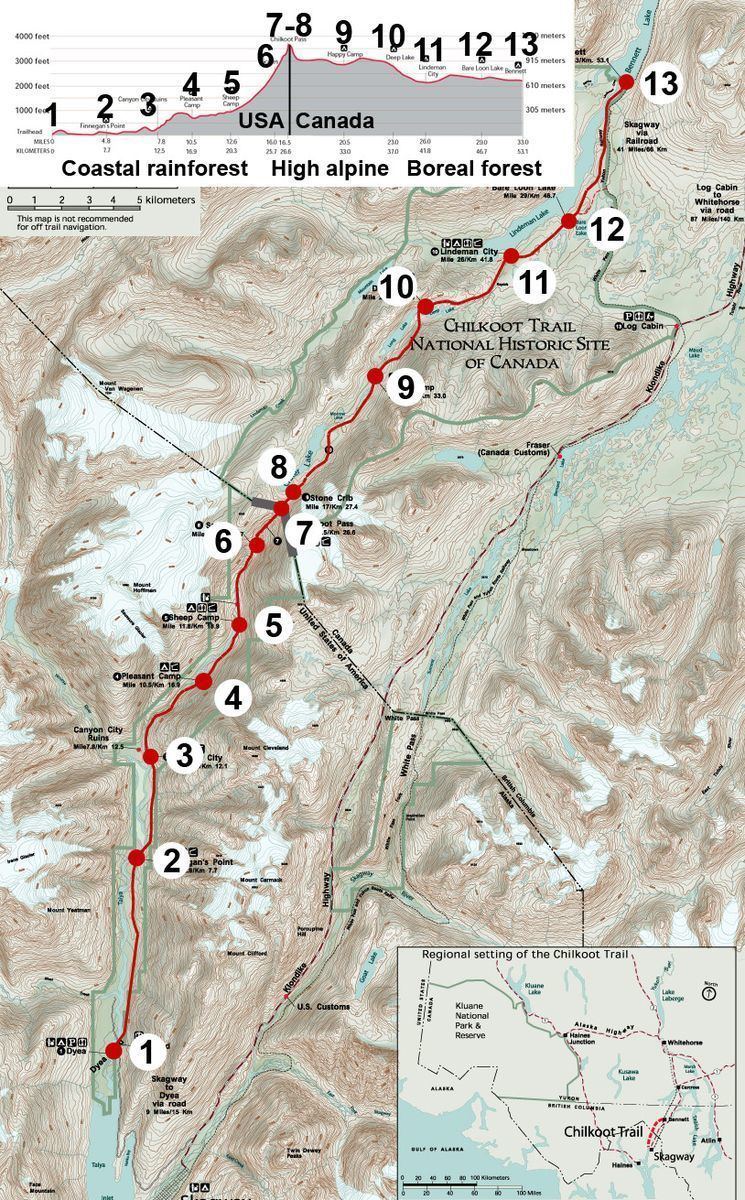 | ||
There are a total of nine designated, maintained campgrounds on the Chilkoot Trail, a 33-mile (53 km) trail through the Coast Mountains that leads from Dyea, Alaska, in the United States, to Bennett, British Columbia, in Canada.
Contents
- Finnegans Point
- Canyon City
- Pleasant Camp
- Sheep Camp
- Happy Camp
- Deep Lake
- Lake Lindeman
- Bare Loon Lake
- Bennett
- References
Camping is allowed in these places only. For heating a backpacking stove must be brought along, even though wood stoves are available in some places. Open fires are prohibited. Use of campgrounds must be planned in advance.
Finnegan's Point
This campground is located adjacent to the Taiya River while the valley is still relatively flat. The mosquitoes are very bad at Finnegan's Point partly due to its location and the abundance of standing water. The campsite itself includes a canvas warming and cooking shelter with mosquito screens, a bear pole and a bear-proof food storage locker, an outhouse, and ample tent sites. Finnegan's Point often takes in very few hikers because of its proximity to the trailhead, and most parties pass Finnegan's Point within a few hours. However, for slower parties and those with a late start on the trail, Finnegan's Point is often the campground of choice.
The campground receives its name from Pat Finnegan, who enterprised to collect bridge-crossing tolls from stampeders. Finnegan's Point consisted of a "huddle of tents surrounding a hard core of blacksmith shop, saloon, and a restaurant."
Canyon City
The second-largest campground on the American side of the trail. It is located next to small tributary of the Taiya River. Canyon City includes a log cabin with a wood stove and several bunks (although sleeping is not permitted inside park shelters), several shelves for cooking, and a small porch for drying gear. Canyon City includes more than 30 campsites and two outhouses as well as food lockers and bear poles.
Pleasant Camp
This is the smallest of the campgrounds on the American side of the trail. It is located next to a sandbar in the Taiya River and consists of a canvas warming and cooking shelter, a small number of campsites, and a bear pole. Pleasant Camp usually serves as a spillover campsite if Sheep Camp is full. There is a sign near the cooking shelter notifying backpackers whether Sheep Camp is at capacity or can still take backpackers.
Sheep Camp
This is the largest of the American campsites. It is located adjacent to a braided Taiya River. Occasionally avalanches, rockslides, or exceptional rains, will flood Sheep Camp. Sheep Camp consists of three canvas shelters, a small cache used by the trail crew, outhouses, and over 40 campsites. A large (bigger than all three canvas shelters combined) post-and-beam picnic pavilion is currently (Aug 2016) being built adjacent to the shelters. The only U.S. Ranger Station on the trail is located just a few hundred meters south of Sheep Camp and the ranger during the official season gives a nightly presentation on the history of the pass and current weather and trail conditions. From Sheep Camp many hikers leave early in the morning—as early as 4 a.m.—for the summit push into Canada. During the official hiking season the park ranger stationed just south of Sheep Camp gives a quick presentation outlining the route over the pass, the weather forecast, and snow conditions. Rangers recommend 7.5 to 10 hours for a group to travel from Sheep Camp to Happy Camp.
Happy Camp
Happy Camp is the only campground on the Chilkoot Trail in the alpine. A very small wooden warming cabin, an outhouse, and a modest number of campsites are all available at this campsite. Happy Camp owes its name to the relief prospectors (and hikers) experienced from arriving at the first outpost after the pass. The camp is situated in a true alpine ecosystem and receives heavy use because of its location.
Deep Lake
Deep Lake is one of only two campgrounds on the trail without permanent or semi-permanent shelter. Deep Lake includes an outside cooking area, bear proof lockers for food, and a small number of campsites. It is notable, however, for its scenic location, between the indigo hues of Long and Deep Lakes.
Lake Lindeman
The largest campground on the Canadian side. It includes separate north and south campsites, a small cluster of buildings for the trail warden and trail crew, a dock and Parks Canada powerboat, a canvas shelter containing a museum of photographs and small library on the outdoors and Klondike history, and a web of trails leading among the remains of the old town. The north and south campsites each include a large wooden cabin that serves as a cooking and warming shelter, numerous bear poles, and several picnic tables. The campsite is located on the site of what was Lindeman City during the gold rush: a cemetery of deceased prospectors from the gold rush era remains, as well as numerous foundations, former fire rings, old latrine holes, the ruts of Lindeman City's main street, and a plethora of artifacts ranging from broken wine and beer bottles to tin cans. Lake Lindeman hosts a small tent museum containing photographic displays and a small library of books on the Chilkoot, the outdoors, and other Canadian parks.
Bare Loon Lake
Bare Loon Lake is the second campground without semi-permanent shelter, though it now includes a pavilion-style cooking shelter. Located on a small ridge above Lake Lindeman in a pine forest and overlooking the Bare Loon Lake, the campground is one of the most beautiful on the trail. It includes two outhouses, a helicopter pad, and food lockers.
Bennett
This camp is the end of the trail. Several structures maintained by the White Pass and Yukon Route are clustered around the tracks, as well as a private First Nations residence. The campground is relatively small and includes bear poles, picnic tables, and an outhouse.
